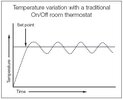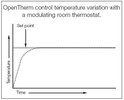In an ideal world, and that does not in the main exist, we would expect to find a hub
something like the wiser one shown, which can connect to boiler's ebus
using the little white bit shown in the picture, using analogue connection (well really more like 256 steps, but near enough analogue) and the hub in turn connects to wall or radiator thermostats (TRV)
with the latter there is no real need for a wall thermostat as thermals in the room mean the TRV is normally ideally placed.
However, with careful adjustment of more simple system can work, the old method given in the text books was a wall thermostat placed in a ground floor room, as heat raises, with not alternative heating or cooling, so no outside doors or stoves etc, even windows likely to catch the sun, and kept cool so on warm days it will not be triggered, and no TRV in that room, but back in the real world, such a room rarely exists, so we look to near enough engineering, which often breaks the rules by having a TRV and wall thermostat in the same room, often the hall, to get around the fact when the outside door is opened it cools the room down, and the diagram given
of how the heat should move in the room, does not work, as there is a staircase in the room, so it will never circulate as shown.
So we select key rooms instead, which are the key rooms depends on your lifestyle as well as the house, but in a 4-bedroom house, if one bedroom has a linked TRV head, and the other three have the same schedule set, then the other 3 can have non linked TRV heads, as the one with the linked head will trigger the boiler to fire.
The important bit, is to have a hub, which can have items added to it, I made a mistake, I got Nest Gen 3 as it said it worked with Energenie TRV heads, they don't, so now have a wiser hub in parallel with the Nest heat link (hub) so at the moment 2 key rooms with wall thermostats, the hall and living room, intend to fit a Wiser TRV to wife's bedroom as well.
My boiler is rather simple, so I manually adjust the output temperature, start of winter and spring it is set low, and heart of Winter set higher, modern boilers have outdoor sensors which do this for you.
Again my old oil boiler simply turns on/off, so I always get a hysteresis, modern boilers with analogue control can avoid this.


As shown, again in theory no room can overheat, as the TRV will stop it, and the wall thermostat is there to stop the room being cold, but in real terms not that simple, in the summer I love a room at 17ºC, but in winter want 20ºC. I would only turn on the AC at 24ºC, but would not want 24ºC in the winter. The AC is easy, if I need it there is loads of sun, so the solar panels are making more power than they use, and even without the AC no real worry, we have too many power cuts to consider an electric powered central heating, the sun and batteries may keep the pumps and boiler running, but not enough to heat the house. So waiting for a year when no power cuts over 6 hours reported before considering heat pumps.



